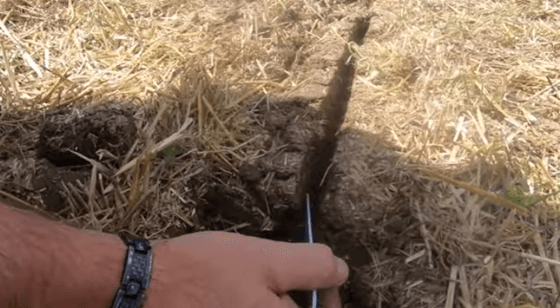“Every planter in the world has the same functions, explained Livingston. “You remove residue, penetrate the soil to open the trench, place the seed in the trench and then destruct the trench so that there’s no evidence that you were ever in the field.”
At the beginning of each planting season, Livingston urges growers to do a test strip in the field which will enable farmers to evaluate the trenches.
"When you’re all set up, take the planter to the field and take the closing system off of one row unit – or tie it up – so that you can do a strip in the field that's 50-100 feet”, said Livingston.
Next step is to locate the seed and assess the seed environment – Livingston uses two different seed depth finders – a traditional seed depth finder that will show you the depth of the seed and whether or not it’s placed in moisture – and also a wider designed seed depth finder which enables farmers to dig down to the base of the seed trench to see if all aspects of that trench are eliminated.
Livingston also discussed the importance of understanding what these seed trenches are doing and what you, as a grower, are trying to accomplish.
“All closing systems have their limitations somewhere, so you need to evaluate your soil and figure out what that limitation is,” he added.
A square-head shovel is a good tool to use for evaluating the seed trench as farmers can insert the shovel into the soil and pull straight back exposing more of an area to evaluate. In Livingston’s demonstration, he discovered that this trench had side-wall compaction.

“The weight of the planter cutting open the trench and pushing to the side has created side-wall compaction. Since the closing system is off, it allows us to see where the seeds are in the trench and allows us to look at how much weight we’re carrying,” he said.
The question now becomes, can you close that trench? Closing the trench is important to eliminate all the air pockets around that seed.
Livingston also discussed Precision Planting’s two-stage closing system, FurrowForce.
“The first stage - stitch wheels - penetrate into the ground, concaved and angled, to lift the soil back up to fracture it, eliminating most of the side-wall compaction,” he explained. “This allows the second stage wheel to push it down and pack that soil, taking all the air pockets out.”
The 2020 Great Ontario Yield Tour Final Event was held online on September 2-3, and featured several presentations from experts, and event hosts and sponsors. Corn and soybean samples were taken by scout on hundreds of farms across Ontario. At the end of the tour, province-wide corn and soybean yield estimates were released, as well as regionalized estimates for south, east, central, and western Ontario. Precision Planting’s presentation was given as part of the final event.
Photo: precisionplanting.com
Related Articles
Ont. soybean yield could be record-breaking: https://www.farms.com/ag-industry-news/ont-soybean-yield-could-be-record-breaking-710.aspx
Maximizing corn production profitability: https://www.farms.com/ag-industry-news/maximizing-corn-production-profitability-049.aspx
2020 U.S. & Global Soybean Market Outlook: https://www.farms.com/ag-industry-news/2020-u-s-global-soybean-market-outlook-051.aspx
Do you truly know your harvest loss? https://www.farms.com/ag-industry-news/do-you-truly-know-your-harvest-loss-142.aspx